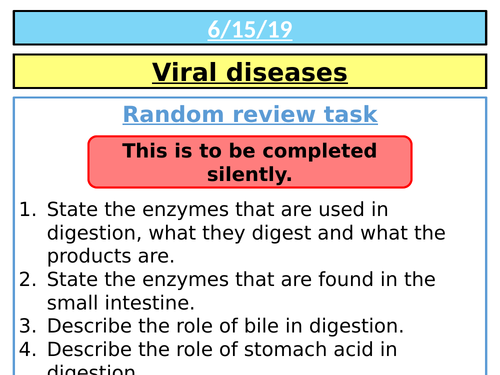
42Uploads
7k+Views
1k+Downloads
Biology

Critiquing evidence and sources
Seventh lesson in a the enquiry processes and safety lessons series. This lesson focuses on how to critique evidence and sources related to scientific literature allowing pupils to assess the reliability of a resource.

AQA GCSE 9-1 - Malaria (Protist disease)
This lesson has been planned for a low-middle attaining GCSE group, can be easily differentiated up for high attaining groups. The Malaria life cycle activity is differentiated for all levels - but can be edited depending on your group. The preview pictures distort what the resources look like.

AQA GCSE (9-1) Biology (Triple) - Preventing bacterial growth
The lesson is in line with B5.4 (Kerboodle scheme of work).
This is an opportunity for pupils to look at their bacteria slides ; describe and explain the differences between antiseptics, disinfectants and antibiotics; calculate the number of bacteria in a colony; analyze and compare zones of inhibition on a bacteria plate.

AQA GCSE (9-1) Biology - Viral diseases
The lesson is in line with B5.6 (Kerboodle scheme of work).
This lesson covers how viruses infect and cause damage to organisms; information regarding measles, HIV and tobacco mosaic virus(information sheet attached. Depending on group ability there is a whiteboard quiz, level 1-4 question sheet, level 5-9 question sheet.

AQA GCSE (9-1) Biology (Triple) - Culturing microorganisms
The lesson is in line with B5.4 (Kerboodle scheme of work).
This lesson outlines the needs that bacteria have with regards to growing effectively; RPA 2: investigate the effect of antiseptics or antibiotics on bacterial growth using agar plates and measuring zones of inhibition; calculating zones of inhibition.

Recording data
Fourth lesson in a series of lessons on enquiry processes and safety. This lesson focuses on how to record data and how it is presented.
This lesson uses an A3 sheet that students can use to while they complete the lesson.

Data analysis
Fifth lesson in a series of lessons on enquiry processes and safety. This lesson focuses on how to analyse data including graph drawing and interpretation.
This lesson uses an A3 sheet that students can use to while they complete the lesson.

AQA GCSE (9-1) - Health and disease (interpreting data)
First lesson for communicable diseases outlining: the difference between communicable and non-communicable diseases; interacting factors; how bacteria and viruses make us ill; the difference between correlation and causation; how pathogens are spread.

Laboratory safety
First lesson in a series of lessons to cover enquiry processes and safety in science. This first lesson covers basic laboratory safety and can be used as a first lesson for year 7 or year 8 as a reminder.

Laboratory equipment & Bunsen burner safety
Second lesson in the enquiry processes and safety lessons series. This lesson focuses on the different laboratory equipment students will need to be confident using in order to carry out practical investigations.
Also contains how to use a Bunsen burner with a Bunsen burner license template.

AQA GCSE (9-1) Biology (Triple) - The brain
A full lesson on the brain covering all the content in the AQA specification for component 4.5.2.2.

AQA GCSE (9-1) Biology (Triple) - The eye
All full lesson covering half of the content needed for the AQA specification component 4.5.2.3. Problems with the eye is the other lesson linked to this one.

Evaluating data
Sixth lesson in a series of lessons on enquiry processes and safety. This lesson focuses on how to evaluate data.
This lesson uses an A3 sheet that students can use to while they complete the lesson.

AQA GCSE (9-1) - Biology - Preventing infections
This lesson covers how infections can be prevented and how hygiene practices have changed over time.

Planning investigations
Third lesson in a series of lessons on enquiry processes and safety. This lesson focuses on how to plan investigations and carry them out safely.
This lesson uses an A3 sheet that students can use to while they complete the lesson.

AQA GCSE (9-1) Biology (Triple) - Removing waste & the kidneys
All full lesson covering half of the content needed for the AQA specification component 4.5.3.3. Kidney transplants and dialysis is the other lesson linked to this one.

AQA GCSE (9-1) Biology (Triple) - Plant hormones
A complete lesson covering all the content needed from the AQA specification components 4.5.4.1 and 4.5.4.2 (including RP 8).

AQA GCSE (9-1) Biology (Triple) - Controlling body temperature
All full lesson covering half of the content needed for the AQA specification component 4.5.2.4.




















